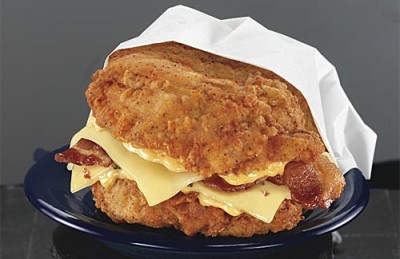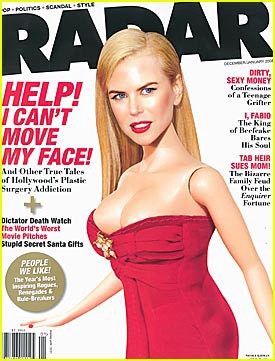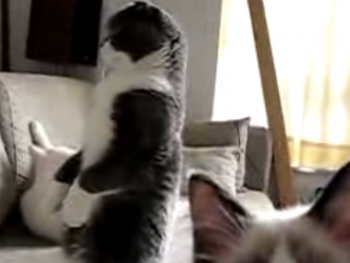The Definitive KFC Double Down Review

You are almost certainly aware of this, but today is not just any Monday. In the same way that we all remember September 26, 2006 as the debut of Burger King’s Chicken Fries, April 12th, 2010 will be seared upon our historical consciousness as the premiere of the new KFC sandwich, the Double Down. I’m afraid I must confess that when I-a connoisseur of speedily-prepared foodstuffs-first heard about this sandwich, I found the concept distasteful and thought myself unlikely to sample it. But here I am, having eaten both of the available versions and writing about them on the internet.
If you aren’t familiar with the Double Down, here’s some marketing language from the Colonel’s website that breaks it down:
The new KFC Double Down sandwich is real and it’s coming April 12th! This one-of-a-kind sandwich features two thick and juicy boneless white meat chicken filets (Original Recipe® or Grilled), two pieces of bacon, two melted slices of Monterey Jack and pepper jack cheese and Colonel’s Sauce. This product is so meaty, there’s no room for a bun!
One of the best things about this blurb is that they had to make sure people understood that this was not actually some sort of amusing prank or illusion. Which makes sense really. If someone told you KFC was coming out with a sandwich that used either grilled or fried chicken in place of bread and bacon as the “meat,” accompanied by multiple layers of cheese, and then a sauce, you might assume it was some clever comment on America’s obsession with fast food and subsequent obesity. So I suppose an assertion of the product’s actuality is both warranted and necessary.
Also, KFC is not lying. An accurate review of the sandwich is pretty much: “This product is so meaty, there’s no room for a bun!” In fact, I should probably stop wasting everyone’s time because that’s the most systematic description of the sandwich that could ever be written. But you know what? I ate both of these things. You’re going to sit here as I walk you through each component of this “sandwich”/”product” and like it.
So let’s get to it and break the Double Down piece by piece.
The “Buns”/Fried Chicken and Grilled Chicken
There are two options when ordering a Double Down: one can either select the grilled version or the fried version (or, in my case, both). The grilled version offers the breakout (right?) KFC item of last year: the Grilled Recipe filet. It evokes a less ambitious Boston Market/Kenny Rogers’ rotisserie chicken. It’s not terrible, and is actually probably better than you would think it to be, but it’s definitely not good. (to clarify the comparison, let’s establish in the context of this review that the Boston Market/Kenny Rogers’ rotisserie breasts are adequate but not exceptional.)
The fried option is essentially the chicken breast they serve in the buckets that you may or may not remember from your childhood depending how awesome or unawesome your parents were. While undoubtedly palatable, I’ve never found the Colonel’s blend of flavors to be my cup of tea. Which should not be taken as a disparagement of all fast food fried chicken; I am no stranger to Bojangles’ and Popeyes-the former being much better than the latter, but both ranking significantly above KFC for me.
What I’d point to as the major flaw in this sandwich-in its underlying principle, really-is that both varieties of chicken, particularly the fried, out-muscle and overpower the rest of the sandwich with the intense taste of saltiness. Make sure you get a drink. Actually, if you’re ordering the Double Down, you should probably get water instead of a fountain soda, because you are going to be really parched both during and after the act of consumption. Also, you don’t NEED a soda.
The Bacon
Sadly, the belly of the hog is pretty much an afterthought. To be frank, by the time I had turned my attention to the grilled version I was unable to perceive even the existence of bacon. I thought to myself, “Hey, maybe the grilled one is the ‘healthy’ version! Maybe I could try this again!” But nope, that wasn’t the case: There was bacon in that one too, only I just couldn’t tell. It’s either because the chicken, cheese, and sauce are all so flavor-full/salty and the bacon is kind of “meh,” or because the bacon is kind of flimsy and afterthought-y. Or maybe it’s because I was eating my second KFC Double Down in the span of 15 minutes and at some point your palate gives up and says, “F you, if you’re not going to treat me with respect you don’t deserve to taste.” I’m still not sure.
The Cheese
If you like gooey cheeses that promise the suggestion of a flavor with which you are familiar without actually presenting such flavor, this is going to be up your alley. The cheese, much like the chicken-or perhaps because of the chicken-has sort of a salty and nutty thing going on. It’s more identifiable than the bacon while eating, but this may be more a product of consistency than actual flavor.
The Colonel’s Special Sauce TM
It’s pretty much Thousand Island dressing. I think it’s safe to say that when a fast food chain promises a special sauce, it’s going to be Thousand Island dressing. If you’re share my affections for the McDonald’s Big Mac, note that that special sauce is also Thousand Island dressing, although if have waded this far into a review of a fast food sandwich that uses chicken instead of bread this is almost certainly a fact of which you had prior knowledge.
(Sidebar: Did you know that there’s actually a place in the world that is called Thousand Islands, somewhere between us and Canada, that may be the origin place for Thousand Island dressing? It turns out that there’s a pretty interesting-relative, perhaps, to this review-debate about it on the Thousand Island dressing Wikipedia page! Spoiler alert: passive aggressive comments arguing about salad dressings are behind that link!)
Nutrition (LOL!)

So KFC claims that the two Double Downs only have 540 and 460 calories each (fried and grilled, respectively). At the risk of being unfortunately unpleasant, I’m forced to express my disbelief of those numbers, because there’s no way that these things have less calories than a Big Mac (without cheese!). Also, if you look on the board at your local KFC (or at least at my local KFC), there’s a calorie count for the meal, which comes with potato wedges and a drink (you fatty!), that counts the calories at 475–1080.
Further to this issue, Susan Levine, the nutrition education director for the Physicians Committee for Responsible Medicine, has issued a letter to Yum! Brands Inc. (operators of KFC, obvs) insisting that the shouldn’t advertise the Double Down to children. Levine feels that the “sandwich” is a “troubling symbol of corporate irresponsibility.” She also believes that the FDA should restrict Double Down advertising in a similar manner to the way it handles tobacco advertising. Sorry, phallus-faced Camel who’s eating bacon surrounded by pieces of fried chicken, your kind isn’t wanted here.
(Sidebar 2: Did you know that KFC also offers a Double Chocolate Chip Cake that is 1700 calories? I mean, truth be told, it looked pretty dope, but 1700 calories? Holy crap.)
Overall
Should you eat this? Probably not. It is very much what you think it is, a sloppy and salty mess, and will make your stomach hurt for several hours after you’ve consumed it.
Still, I asked the KFC employee behind the counter how the Double Downs were doing, mostly in the hope that I would have been the first one to order this creation. It was not to be: Apparently my local KFC affiliate has been serving them for “a few days” already. In fact, they are “selling a lot so far.” So I guess that’s cool. America, we did it! We, like the Double Down, are pretty much exactly what people think we are.
Awl publisher David Cho previously reviewed the products prepared on the new Burger King broiler. The Awl has no financial arrangements with KFC or its parent company Yum! Brands, which should be pretty obvious right now.
Lice! In Bel Air!

Demonstrating that there is, in fact, nothing too small to serve as fodder for monied obsession, New York Times Sunday Styles correspondent David Hochman conducts readers behind the front lines in the upscale war on lice.
The hair-nesting pests typically send upper-class parents-already notorious for the suffocating anxiety they incur at the first sign of any faint tilt toward normal (let alone irregular) symptoms and behaviors in their otherwise radiant spawn-into over-corrective frenzies. Hochman sits in on a home-delousing session at the house of an Angeleno mom who is “clearly mortified” at the discovery that her three kids re harboring the little mites-”which probably explained why she insisted on anonymity,” he stipulates. “We thought we would be the last people on the block to get lice,” the shaken mom explains-and just as firmly, she stresses that “I certainly wasn’t going to pick them out myself” after her nanny had seen a tiny wriggling lice hive in her eldest daughter’s hair.
No, that is the work of the roving delousing contractor business, a sector that “even in recessionary times… appears to be thriving,” Hochman notes. There are on-call home delousing services from Dallas to Los Angeles to New York, who pick through the hair of afflicted children-sometimes using a heat-based suction device called the LouseBuster-for a cool $300 to $500 per visit. (And with rich parents being such reliable reserves of hair-trigger anxiety, it seems rare that a single home delousing visit is enough to allay their alarm over the Enemy Within.)
In medical terms, this is all of course much ado about extremely little. Lice have posed almost no serious health threat, at least in developed countries, since the introduction of a successful vaccine for the spread of infectious typhus, the killer plague that had been transmitted via lice-borne bacteria, and claimed millions of lives in past epidemic outbreaks. “There are very few health consequences associated with head lice beyond the ick factor,” Barbara Frankowski, a pediatrics specialist at the University of Vermont explained to Hochman. “If anything, having head lice is really just a hassle.”
But obviously the pest’s historical associations resonate in a far more powerful fashion at the upper end of the socioeconomic spectrum, if news of a lice infestation on a tow-colored privileged young head is enough for “otherwise sensible, composed parents” to be “reduced to panic,” as Hochman observes. That’s not because of the rhetorical “no” invited by the piece’s typically skylarking Sunday Styles lead query: “Is there any creature less sexy than a louse?” (an especially inapt bit of faux-sophisticated skylarking, by the way, in reference to an affliction that principally affects young children). No, the reason that lice can plumb such deep-seated anxieties in the clucking parental overclass is that throughout history, they have spread in conditions of poverty-an association that’s never mentioned in the Styles dispatch, which instead just gins up a vague sense of generic distaste in expressions such as “ick” and “gross” to characterize the head-inhabiting critters and “repulsed” and “alarmed” to depict their disorienting impact of the heads of well-to-do households.
You get a much stronger sense of the social stigma that has long accompanied lice infestations by glancing at the popular terms for typhus outbreaks throughout history. There was the neutral-enough “louse-borne typhus,” to be sure, but the more vernacular terms for typhus pointed up where the typhus bacteria bred most freely-in the kind of close-quarters institutional settings disproportionately populated by the lower orders. Hence “jail fever,” “hospital fever,” “ship fever” and “camp fever” (as in military encampments) all served as shorthand expressions for the disease. Indeed, typhus was so widespread in past military campaigns, where sanitation was poor and living quarters extremely close, that the disease claimed more lives in Napoleon’s failed 1812 offensive against Russia than were sacrificed on the field of battle. (Indeed, since lice bred freely in Russia’s pinched peasant economy, typhus also served as a critical line of defense against Hitler’s foiled Eastern Front offensive during the Second World War, as Time magazine explained in its colorfully titled contemporaneous account, “Death Rides a Cootie.”)
So today’s upper-crust cootie anxiety reflects more than just the “ick factor” that comes with a close encounter of the louse kind-or the invidious smugness conveyed in the notion “that we would be the last people on our block” to incur a lice infestation. It partakes of a much broader sort of race memory of our ruling class: the alarm that, in the crush of modern urban congestion and casual contact with the strange new immigrants from Europe who made up much of the merchant and servant class in the nation’s great metropolises, rich families might not only meet with serious health hazards, but could also suffer the unbearable stigma of a disease that signified fraternization with the poor. (Much of this anxiety was conveniently distilled in the figure of Mary Mallon, the 19th-century immigrant Irish cook who may have helped trigger a stateside typhoid epidemic, and thus came to be known as “Typhoid Mary.”)
This association took on its most toxic form in Nazi Germany, where propaganda campaigns identified Jews directly with lice, and SS leader Heinrich Himmler famously defended the Final Solution by proclaiming that “antisemitism is exactly the same as delousing.” (In an odd turn of events, Holocaust deniers have taken to claiming that gas chambers at several Nazi concentration camps employed Zyklon-B only for delousing their inmates-one of countless claims these moral imbeciles have aired in defiance of a mountain of contradictory evidence: namely, that many camp inmates died of typhus associated with the inhuman conditions they endured, Anne Frank among them.)
None of this is to equate the rich American rage for lice-scoured youth with Nazi extermination campaigns, of course. It is, however, to note that we often harbor instinctive revulsions for reasons far more complicated than finding their sources to be “gross.” And it’s also worth bearing in mind that hypersanitary moral panics of the privileged orders can be quite destructive epidemics in their own right.
How To Lose Friends: Botox

“Blocking facial expression diminishes the experience of emotion. Our faces are normally alive with activity, which contributes to our understanding of each other, and there is a strong link between our facial expression and our ability to comprehend the meaning of language. If people seem slow in reacting to what they are being told, it is likely to be interpreted as a lack of sympathy or interest.”
–University of Wisconsin-Madison David Havas explains his study showing that Botox may damage social relationships. No word on whether or not it will help you win an Academy Award, though.
Old Jews Make Everything More Interesting
I do not now, nor will I ever, watch “The Real Housewives of New York,” but I did enjoy very much this analysis of the show from negotiation expert Herb Cohen. And now I can go back to not paying it any attention!
Marina Abramović, "The Artist Is Present"

It was an absolutely gorgeous weekend here in town, offering the kind of “first days of spring” feeling that tempts one to forget that life is essentially meaningless and we are all ultimately alone. So I headed up to MoMA, because nothing helps me remember the existential horror of humanity better than the sculpture of Alberto Giacometti. While I was wandering through the museum I could not help but notice the Marina Abramović performance piece “The Artist Is Present.” There are other Abramović pieces being performed upstairs, which include nudity. Nudity! But let’s talk about the one where she sits at a table and stares. I was surprised by how transfixing it turned out to be.
When I arrived there was a blonde woman who appeared to be in her early fifties seated across from Abramović. She had clearly been there for some time. What’s interesting about this exhibit-or at least was for me-is the way it encourages you to read the faces of the participants. Abramović remained impassive the whole time, and the woman across from her had an unchanging expression as well, but what was it? Intensity? Confusion? Something altogether difficult? It was impossible to tell.
A project like this one is an easy target for the whole “You call that art?” dismissal, although you could probably say that about most of what’s in MoMA. I am too tired to find that philosophy at all worth entertaining. Marshall McLuhan’s famous dictum that art is anything you can get away with is perhaps more helpful, if no less reductive, but here’s the thing: I spent more time watching two people sitting across from each other in the middle of a room than I did with any other work at the museum. And it was really nice out! I could have been in the sculpture garden!
I circled back to Abramović throughout the afternoon, and the same woman was still there. People who had joined the line to be part of the piece were clearly agitated, and at one point I saw a young man talking to an older fellow, complaining that he had been waiting all day and wondering how much longer he thought the woman would be there.
“If you can get her attention,” said the older man, “good luck.”
He was dressed casually. He spoke with a soft southern accent and took the occasional picture of the pair. I approached him once the disgruntled kid left.
“You’re with her? How long has she been there?”
“Been an hour already,” he said, shaking his head.
“Apparently you lose all track of time when you’re sitting there,” I said.
“Must be something like that, because I don’t even know if she sees me.”
It was getting near closing time, and she still showed no sign of moving. The folks on the line looked resigned. Whatever Abramović was doing, she was certainly getting away with it.
“Well, good luck. I hope you guys are going somewhere nice to eat after this,” I said.
“We’d better,” he replied. “I’m frigging starving.”
The piece runs through the end of May. You should probably go see it.
Tao of Dow: When Standing Cats Attack
by Simon Dumenco

The Awl’s Morning Market Report:
• The Dow Jones Industrial Average inched up this morning as investors expressed relief that Standing Cat is not a crazy Asian chick in a very convincing cat suit, but an actual cat named Rocky that French journalist Aude Baron reveals, via Boing Boing, “is 2 years old and his owners are French (Daisy and Yann). Rocky used to stand up because he couldn’t see the birds through the windows, and wanted to, so he stood up…. He doesn’t stand up too often any more because Daisy and Yann moved their stuff, so now Rocky can see everything without having to go bipedal.”
• The Nasdaq was basically flat this morning as investors digested news that Standing Cat, who was expected to be a boon for the economy — with planned Standing Cat theme parks, scrunchies, glitter tote bags, Trapper Keepers and bedspreads — was actually pre-dated by other standing felines, including Mocha. Mocha’s been on YouTube since January 2008, and the market is up overall like 2000% or something in the last year, so clearly we have already benefited from the Standing Cat Stimulus.
Terrifying Black Chunnel Migrants Gang-Board Student Coaches -- And Get Glassed!

Here in the great old USA, we have porous land borders, over which Americans slip under cover of night into the welcoming arms of Mexico and Canada. But what about England? It’s an island, basically, I think! (Or is that Iceland?) So when you’re brassic and Lee Marvin and you want to become both 1. illegal and 2. immigrant-well, folks used to have to get a boat to leave the horrid land of France? But now they can take advantage of The Chunnel! So what they do is they hop onto a “coach” (much like “jitney,” that’s English for “bus”) and try to hide in the luggage, in hopes to soon get klangered at England’s yobbiest chav gastropubs. Even coachloads of Scottish students touring Calais aren’t safe from their migratory predations! Fortunately teachers are trained to beat back the knife-wielding would-be black English-folk! It’s law ’n’ order at the border, boyo.
Angry Young Punks Protest

Democratic staffers on the Hill are upset by the public scorn and disdain to which they have been subjected of late, with House Minority Leader John Boehner calling them “little punks” and former Speaker Newt Gingrich referring to them as “arrogant.” While one can see how the young administrative aides in Congress-overworked, underpaid, unable to publicly respond to accusations of incivility-might feel unduly picked on by those whose profile and position make these sorts of complaints seem like the worst kind of bullying, perhaps they should consider this castigation a compliment: All the Democratic staffers did was help get the health care bill through. It’s not that big of a deal when you consider that their counterparts on the other side of the aisle were once instrumental in stealing an entire election. Maybe they should use this as an incentive to try harder.
Understanding the Magnetar Trade

This Magnetar story by ProPublica’s Jesse Eisinger and Jake Bernstein-that went online at the bizarre time of Friday afternoon-is more in-depth than someone as poorly versed in the subject matter as I would need it to be. But it does a good job of showing how, in the years leading up to the recession, some smart and perhaps ethically flexible people got very rich quick by knowingly contributing to misery for so many others-all absolutely within a legal framework, it seems, which is maybe the worst part of it.
Shocking Stallion Slaughter Perturbs Paper

Say this for the Post: when they have a great headline, they don’t hide it under a bushel. The tragic story of three retired police horses who were euthanized because it would be too difficult to transport them to another farm-a situation which everyone who has once been a child might think is the nice way of saying “had them put down”-is gifted with the remarkable title “NYPD Glue.” The article itself is rather unusual in its shock and horror over the whole affair, given that the Post’s editorial line seems to suggest a desire to euthanize all the retired humans from our city’s civil service, lest they draw on the generous pensions their despicable union representatives negotiated in good faith, but I guess people feel different about the ponies than they do about cops and firemen.
